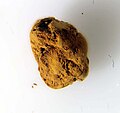Iron ochre
| Iron ochre | |
|---|---|
 | |
| General | |
| Category | Mineral |
Iron ochre or iron ocher (Ancient Greek: ὠχρός, pale yellow, orange) — at least three iron ore minerals,[1]: 134 common abrasives and pigments with a red-brown or brown-orange hue and the powdery consistency of ocher, were known under such a trivial name. The term “iron ocher” was primarily used among mineral collectors, geologists, miners and representatives of related craft professions. It may refer to:
- Iron ochre or hematite[2]: 85 — Fe2O3,[3]: 212 a widespread iron mineral, one of the most important iron ores;
- Iron ochre or limonite[2]: 85 — Fe2O3·Н2О,[4]: 30 a mixture of secondary natural minerals, iron oxide hydrates;
- Iron ochre or goethite[4]: 30 — α-FeO(OH), a product of weathering of ores, a secondary iron mineral, the main component of limonite, is part of brown iron ores;
- Iron ochre, brown iron ocher or lepidocrocite — γ-FeO(OH),[5]: 236 a secondary mineral, a product of the oxidation of iron ore minerals, found in brown iron ores;
- Iron ochre or ferric oxide[3]: 212 — Fe2O3 (oxides of iron), which also occurs naturally as the mineral magnetite;
- Iron ochre or ferrihydrite[6]: 338 — Fe2O3·0.5H2O, is a widespread hydrous ferric oxyhydroxide mineral at the Earth's surface;
Gallery
-
 Hematite
Hematite -
 Limonite
Limonite -
 Goethite
Goethite -
 Lepidocrocite
Lepidocrocite - Ferric oxide
-
 Ferrihydrite
Ferrihydrite
References
- ^ Krivovichev V. G. Mineralogical glossary. Scientific editor A. G. Bulakh. — St.Petersburg: St.Petersburg Univ. Publ. House. 2009. — 556 p. — ISBN 978-5-288-04863-0
- ^ a b Thomas Egleston, Ph. D. Catalogue of Minerals and Synonyms. — Washington: Government Printing Office, 1887.
- ^ a b Sigvald Linné. Archaeological Researches at Teotihuacan, Mexico. Sigvald Linne, with a foreword by Staffan Brunius and introduction by George L. — The University of Alabama Press, 2003. — 236p.
- ^ a b Kimmo Virtanen. Geological control of iron and phosphorus precipitates in mires of the Ruukki-Vihanti Area, Central Finland. — Geological Survey of Finland, 1994; — 69 p.
- ^ R. A. Lidin, L. L. Andreeva, V. A. Molochko, edited by R. A. Lidin. Constants of inorganic substances: reference book. 3-rd ed., stereotypical. — Moscow: Drofa, 2008 г. — 685 p.
- ^ A.M.O. Mohamed. Principles and Applications of Time Domain Electrometry in Geoenvironmental Engineering. — Taylor & Francis, 2006. — 603 p.
See also
- Ochre
- Ochre (disambiguation)
- Iron (disambiguation)
- Iron(III) oxide
- List of inorganic pigments
- Red pigments
- List of colors
- Yellow

Index of articles associated with the same name
This article includes a list of related items that share the same name (or similar names). If an internal link incorrectly led you here, you may wish to change the link to point directly to the intended article.















